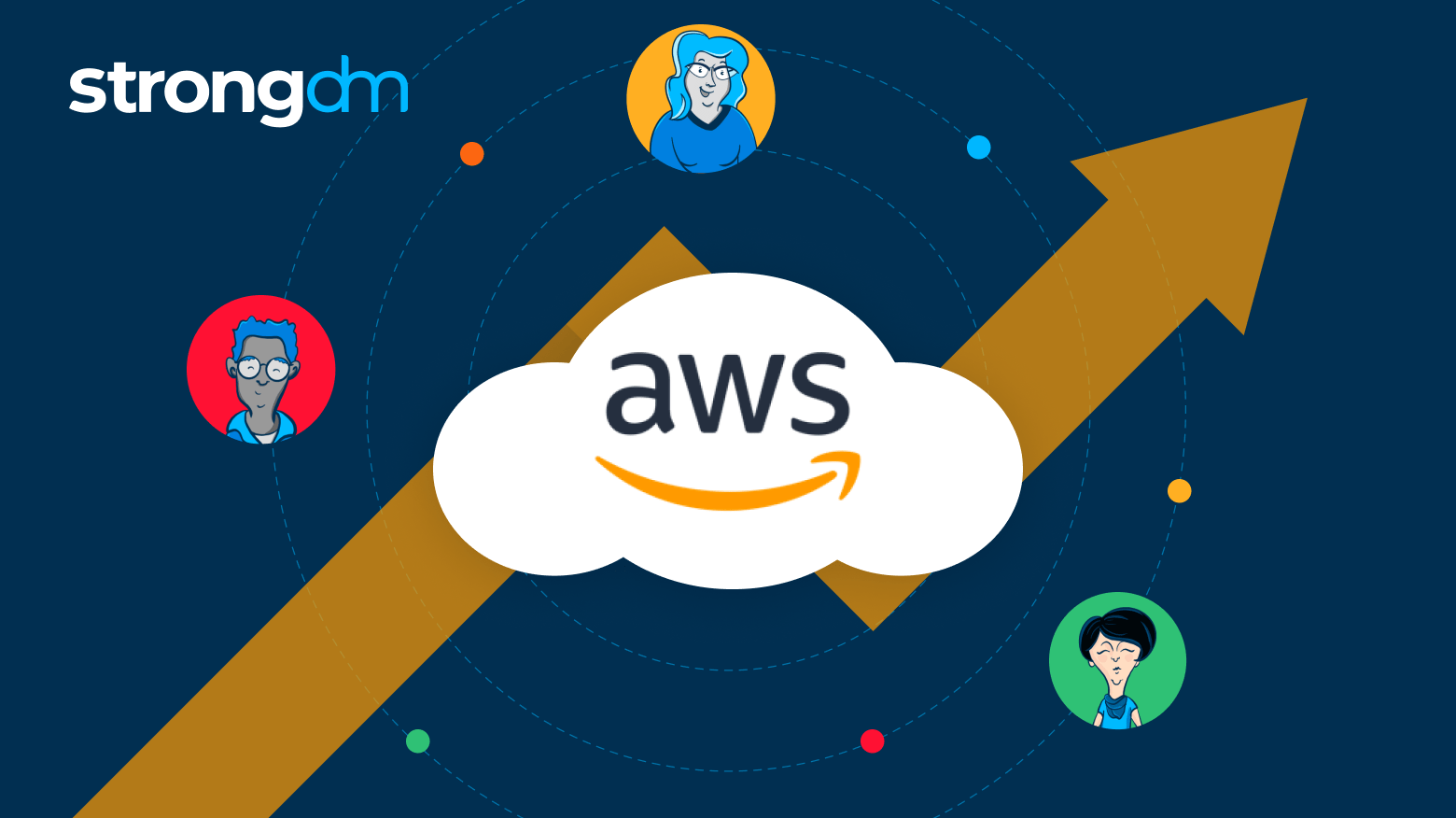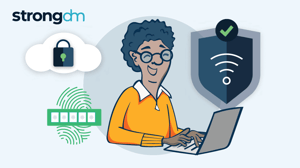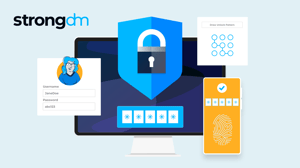

Written by
Schuyler BrownLast updated on:
April 1, 2025Reading time:
Contents
Built for Security. Loved by Devs.
- Free Trial — No Credit Card Needed
- Full Access to All Features
- Trusted by the Fortune 100, early startups, and everyone in between
AWS authentication confirms the identity of users trying to access your resources, safeguarding against potential attacks and data breaches. But weak authentication practices—like easy-to-guess passwords and single-factor authentication (SFA)—are far too common and they leave the door wide open for threat actors.
Weak authentication often leads to data theft, resource misuse, financial loss and reputational nightmares…the list goes on. On the contrary, strong authentication measures like Multi-Factor Authentication (MFA) significantly reduce the risk of these incidents occurring.
StrongDM takes AWS authentication to the next level, going beyond MFA to include granular access controls based on roles (RBAC), attributes (ABAC), and just-in-time approvals.
Understanding AWS Authentication
AWS offers a range of authentication mechanisms, from the traditional username-password authentication to MFA and programmatic access with temporary access keys. Usernames and passwords are the basic login credentials that grant users access to your AWS environment. In this case, it's up to users to choose strong passwords to maintain the integrity of your system.
For secondary authentication, you can enable MFA which can be used at the AWS account level and for AWS Identity and Access Management (IAM) users in your AWS account. AWS IAM lets you manage user permissions and delegate access to different people or services. With AWS IAM roles, you can create users, assign permissions, and set up groups, you get to control which users gets access to your resources and what they can do with them.
AWS provides MFA for an extra layer of protection, which involves a second verification step—like a code from a mobile app or physical device—after users enter their login credentials. Enabling this significantly strengthens the security of your AWS environment.
Limitations Of Relying Solely On MFA For Authentication
Although MFA significantly reduces the risk of breaches, it’s not foolproof. There are still vulnerabilities that could be exploited by threat actors. For example, phishing attacks and compromised devices could be used to obtain verification codes and bypass MFA.
Sure, you could educate users about the best practices for MFA and regularly update MFA configurations and policies, but social engineering techniques exploit human psychology — you can only control so much when it comes to your employees. You may want to consider adding extra layers of protection.
A multi-layered security approach with additional security measures like granular access controls can strengthen your defense against vulnerabilities you can’t eliminate.
Going Beyond MFA for AWS Authentication with StrongDM
Deploying a secure access management solution like StrongDM secures your resources against potential threats. It gives you granular control over privileged user access to databases, servers, and cloud resources, ensuring that users only have just-right access at any given point in time.
StrongDM enhances AWS authentication by allowing organizations to use static and dynamic rules to enforce access controls—based on user roles or resource attributes like resource type and geographic location. Its centralized visibility, audit trails, and compliance reports further simplify access management.
The benefits of using StrongDM for AWS authentication include:
- Centralized access control and management. As a unified platform centralizing privileged access management, you can easily control and monitor user permissions.
- Streamlined user provisioning and deprovisioning. Resource owners can effortlessly grant or revoke access, ensuring efficient onboarding and offboarding of users without hassle.
- Secure access. The local client acts as a tunnel, securely forwarding requests from the user's workstation to the gateway through a single TLS 1.2-secured TCP connection.
- Eliminate credential exposure: Access is granted based on user identity and role without the end user ever needing to see or enter credentials to connect to resources.
- Fine-grained access controls and role-based permissions. Administrators can define and manage user privileges at a detailed level, ensuring the right individuals have the appropriate access.
- Auditing and monitoring capabilities. Audit trails help you track and analyze every activity and query, providing comprehensive visibility into user activities and improving investigation and response times for security incidents.
Best Practices for AWS Authentication
Successful, secure use of any technology is based on the practices you implementaround it. By understanding and executing the following best practices for AWS authentication, you can fortify your AWS environment and mitigate potential security threats.
Implementing StrongDM for secure AWS authentication
Integrating StrongDM with AWS streamlines access management. By doing so, you can seamlessly sync AWS IAM users and roles, centralizing and strengthening user access controls across your AWS resources.
Enforcing strong authentication policies
Start your AWS journey on the right foot with strong authentication policies that protect sensitive data:
- Implement password complexity and rotation policies that encourage users to regularly change and create strong passwords that combine different kinds of characters.
- Enable two-factor authentication (2FA) to reduce the risk of bad actors gaining access with stolen credentials.
- Limit when users can interact with your resources by defining specific time windows for access using time-based access controls.
- Conduct user access reviews and periodic audits to identify and address potential vulnerabilities as they emerge.
Monitoring and logging for enhanced security
Use a tool like StrongDM to gain oversight of user activities in your AWS environment. By consolidating logs and delivering real-time visibility, you can effectively track and analyze user actions which can reveal anomalies and prompt investigations. Plus, you can integrate your consolidated access audit logs with SIEM and SOAR tools to get a clear picture of access risk.
Regular audits of access grants and usage through StrongDM Advanced Insights reports
Conduct regular audits of your AWS access grants and usage with StrongDM Advanced Insights reports to stay proactive. With these insights, you can:
- Track metrics
- Ensure the principle of least privilege
- Provide evidence of enforced security policies
- Efficiently address access audit inquiries
How Benevity Enhanced AWS Authentication with StrongDM (Case Study)
Financial services and human resource company Benevity initially handled access approval requests for user server accounts through a custom Ansible script. But as the company grew, it needed to scale its secure workflows and optimize shell access to EC2.
With StrongDM, Benevity streamlined the process of granting user access. They now automate the internal approval process and leverage role-based access to standardize permission levels across teams.
StrongDM’s audit logs have also proven to be extremely useful to the security team, as they now can see every single query that was run and everyone who accessed it.
“StrongDM is just easy to use. We were able to get it set up and connected without having to ask for help. And now we can do things like retire SSH Key sharing, easily provision access to databases, and provide our security team with auditable access to every single DBs query.”
- Nina d’Abadie, Director of DevOps (source)
Conclusion
Although there is no foolproof authentication method, following strong AWS authentication practices significantly reduces the risk of breaches while minimizing the impact of incidents.
StrongDM offers a secure access management solution that goes beyond MFA to include granular access controls based on user roles, resource attributes, and just-in-time approvals to mitigate all potential threats.
Want to improve your organization’s AWS authentication and security? Check out StrongDM in the AWS Marketplace.
Next Steps
StrongDM unifies access management across databases, servers, clusters, and more—for IT, security, and DevOps teams.
- Learn how StrongDM works
- Book a personalized demo
- Start your free StrongDM trial

Categories:

About the Author
Schuyler Brown, Chairman of the Board, began working with startups as one of the first employees at Cross Commerce Media. Since then, he has worked at the venture capital firms DFJ Gotham and High Peaks Venture Partners. He is also the host of Founders@Fail and author of Inc.com's "Failing Forward" column, where he interviews veteran entrepreneurs about the bumps, bruises, and reality of life in the startup trenches. His leadership philosophy: be humble enough to realize you don’t know everything and curious enough to want to learn more. He holds a B.A. and M.B.A. from Columbia University. To contact Schuyler, visit him on LinkedIn.
You May Also Like




